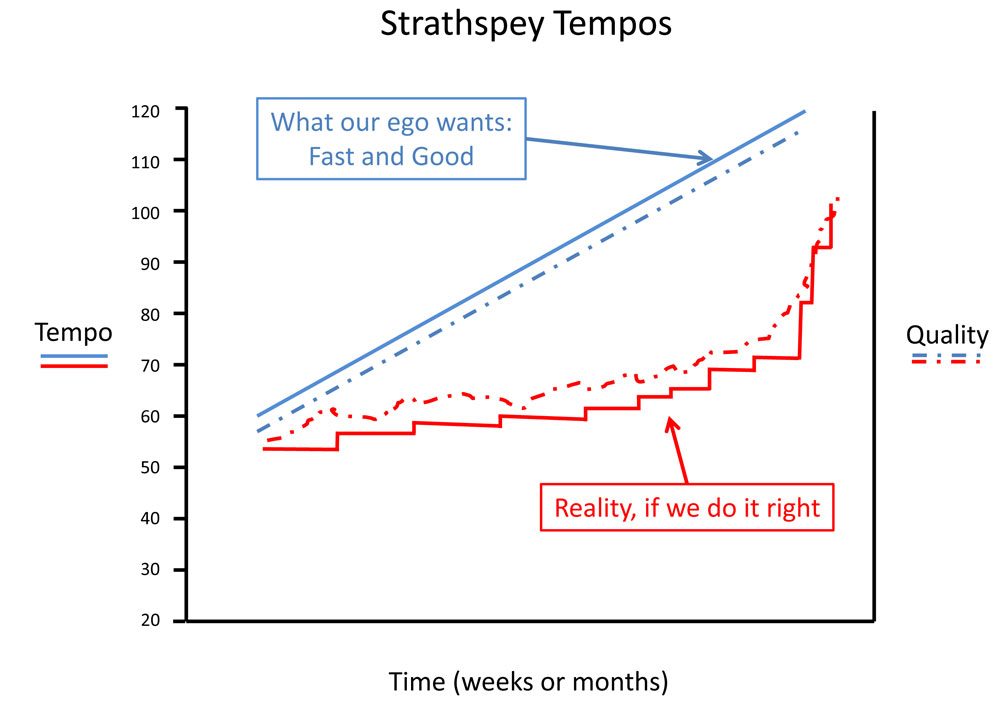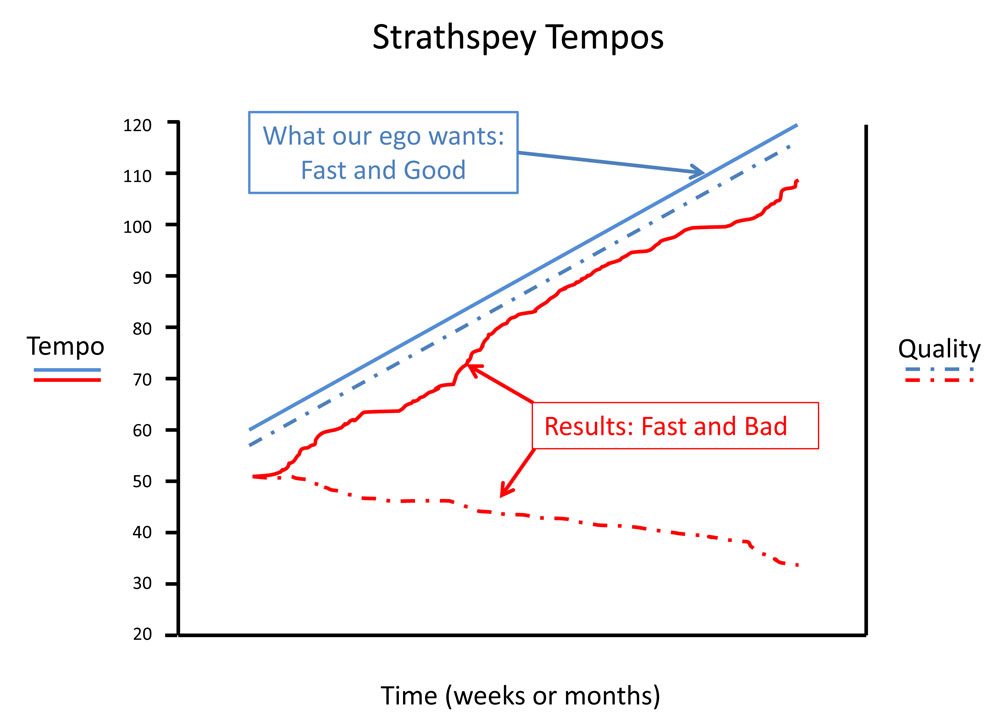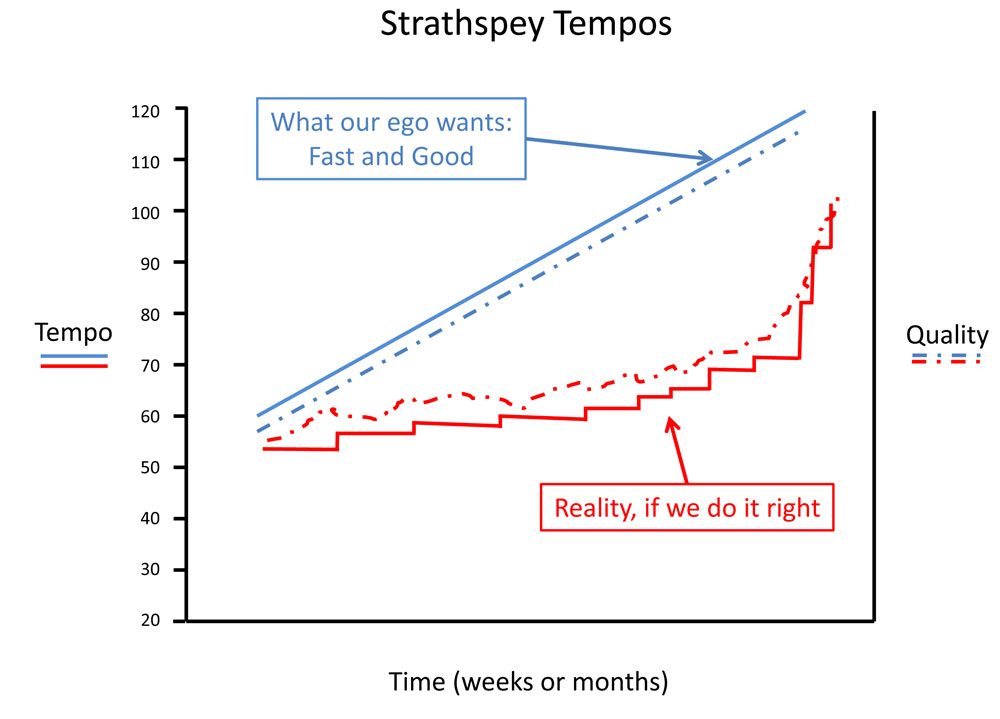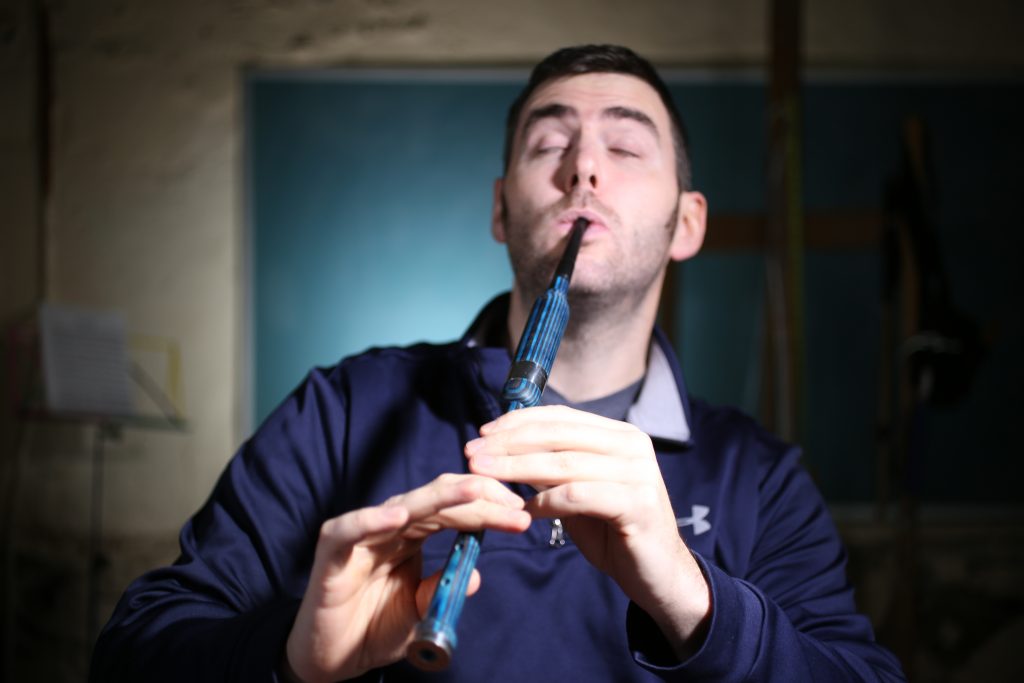Bagpipers: How to Play FAST

Some pipers think that it is really hard to play fast, but they’re wrong. It’s very easy to play fast, even at a tempo that comes close to matching that of Stuart Liddell. Thus, a fast tempo is really no problem at all. The problem arises when we expect to play fast and at the same time make anything that sounds close to good music.
So, why the big disconnect? Well, as far as adult learners are concerned, we are very impatient and for the most part do not want to take the time to learn things correctly, or we don’t think that we have the time to do something right in the first place. And when we’re told in piping to “slow down!”, we often say to ourselves or others, “I really can’t play anything at that slow tempo.”
Let’s examine a couple of examples that might illustrate the problem, and then we’ll talk about potential solutions.
When we listen to the top solo pipers, or Grade 1 bands, we here superb technique and musicality, and we honestly strive to “sound just like they do”. But we don’t think about the work and patience it took to achieve that level. We won’t get into the reasons why adults to be impatient with learning the pipes; suffice it to say that it is a true statement. Examine Figure 1.
Figure 1 illustrates that we simultaneously want to be able to play at a fast tempo, and we want to do it with high quality, as shown in the blue solid and dashed lines. We know that we should 'start slowly', and we do. We might even be using the Dojo tune-building method, where we play only one bar at a time until we get it right, then learn the second bar, put both bars together, etc. But sooner or later, we want to increase the tempo, possibly because we “hear” the good music of the experts. The problem comes in when we continue to increase the tempo without mastering the technique to match the tempo. This failure is shown in the solid and dashed red lines. The divergence between the faster tempo and good quality is clear. Although we try to keep up with the faster clicks of the metronome, we’re not yet comfortable with the technique, but we keep going. We are no longer hitting the beats, and the technique falls apart. Overall, the results of a faster tempo are INVARIABLY BAD, totally disappointing, not what we expected, and often very discouraging. As the tempo increased, the quality of the playing took a nose dive, never to recover.
So, what is the right approach for an eventual fast tempo with high quality music? Let’s turn to Figure 2.
We must remember that each individual has their own learning and playing curves, younger folks learn faster than older folks, etc (or do they...?). But the old adage “speed kills” is true for bagpiping as well as for automobiles. An appropriate tempo to start with, as mentioned above, is about half the final expected tempo. Establish your final tempo, and start at half that. For a strathspey in a Grade 1 band, the final tempo might be 120 beats/minute, for a Grade 3 solo piper, perhaps 105-110 bpm. Whatever the final is, take half of it.
In Figure 2, we see that if we learn a new tune SLOWLY (solid red line), the quality of our playing (dashed red line) steadily improves as the tempo gradually increases. In other words, the quality of playing (good rhythm, no note mistakes, good gracenotes, etc) keeps up with the slowly increasing tempo. Ultimately, we reach the original goal of fast tempo along with good quality.
Practice at that starting tempo, and DO NOT increase the tempo until all you can hit all of the beats, and all of the technique is down solid. It’s that simple. If you’re missing the embellishments or have gracenote synchronization errors at 60, common sense guarantees that the problems can only get worse with increasing tempo by only 2-3 beats/minute. So, don’t even consider a tempo increase until you have things right. Don’t be embarrassed. No, it doesn’t yet “sound” like a strathspey because it’s not up to speed. Be patient, it will come, but not overnight.
When all the technique and rhythm is correct, say at 60 beats/minute, then and only then increase the tempo maybe 5% (5% of 60 is 3bpm). Now the metronome is “only” 63 bpm. Play what you have already learned, listening for any rhythmic errors or problems with technique. Are the G gracenotes in the doublings landing precisely on the beats? Are the Low G’s of the grips or D throws precisely on the beat? If you hear any errors, go back to the previous tempo. Don’t try to do the impossible and increase the tempo and expect better results.
What can we realistically expect if we learn a tune correctly? Obviously, it depends on many factors, such as frequency of practice, duration of practice, etc, but over time (Figure 2), nothing seems to change.
The tempo goes up a little, things are going well, tempo increases just a tiny bit more, and in come the mistakes. Tempo goes back down just a bit, mistakes go away. You stay at that (seemingly boring) tempo a while longer, and the mistakes go away again. Now, when you increase the tempo again, there are no mistakes. Wow, congratulations! So, you stay at that tempo for a while, getting more comfortable with each repletion, and decide to increase the tempo another 5 percent. Whoops, here come a few mistakes! There are not as many as before, but the gracenotes are now sloppy, so you must go back down in tempo.
Eventually, you will be delighted to learn that the number of mistakes and the types of mistakes decrease, even as the tempo increases, as shown in Figure 2, dashed line. That's right, just like when you learn to ride a bike and you finally "get it", there is indeed a "breaking point" where rapid skill-ascension happens in piping too.
The thing is - you have to be patient and wait for "eventually" to get here. If not, guess what the outcome will be? (The outcome will be that you return to this article in a year and slap yourself on the forehead!)
Think about it this way: Which of the following patterns of tempo increase will be more likely to result eventually in a faster tempo AND good music, A or B?
- 60 bpm, 63, 65, 68, 70, 72, 75, 78, 80, 84, 88, etc
- 60 bpm, 70,80,90,100
Remember, the starting tempo is the one where you don’t make mistakes, regardless of the “number”. Sorry, but it’s not a good question to ask, “what tempo should I play?”. Choose the tempo that’s right for you, and progress from there.
So, you now have the answer to the age old question:
Q: How do I play really fast on the bagpipes?
A: Slowly








Responses